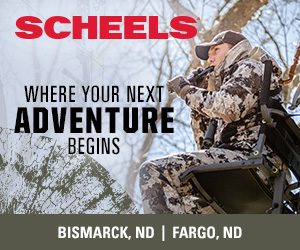
While the expanding technology from calls to optics to ballistics is helping hunters get into the field for furbearers, their keen senses and adaptability make them a challenging target each winter. Simonson Photo.
By Nick Simonson
With the end of fall hunting seasons and significant snow on the ground, many sportsmen are looking to cure an itchy index finger that can’t be satisfied with the snap of an ice rod.
Luckily, throughout the northern plains, plentiful opportunities for coyote hunting exist through the cold weather months, and never before has there been so many chances to not only engage in the pursuit of predators but also to do so successfully. With developments in hunter technologies such as digital calling systems, advanced range finders, scopes tailored to predator hunting and even thermal imaging options, sportsmen can get the edge on these wily canids all winter long.
The popularity of coyote hunting has been on the rise over the past two decades, and according to Jamie Olson, webmaster of coyotehunter.net and professional furbearer hunter and trapper, it’s easier than ever to get into the sport, thanks to a boom of information and advancements in the last 20 years. The biggest impact in Olson’s mind is the development of electronic calling systems for hunters to use in the field which require the simple flick of a switch to help call coyotes into shooting range.
“When I first started calling it was with an open reed…you have to put some time into that to know how to make the individual sounds in order to actually call a coyote towards you,” Olson states, “with the better quality e-callers that have come out not only do they have great sound – Primos, FOXPRO, ICOtec – they’re good quality units and there’s just a large array of sounds, so you don’t have to worry about trying to mimic it with an open reed call, now you just pick the sound that you want to use and hit the button and off you go,” he concludes, referencing the abundance of tutorials online and in digital videos found on e-caller manufacturer’s sites and those such as YouTube, which maximize the effectiveness of electronic calling systems.
Optics and scopes developed specifically for predator hunting and the growing long-range shooting trend have also been a boon to those sportsmen pursuing coyotes in recent years. Olson cites the development of advanced reticles, rangefinders and even thermal technology as being highly advantageous for the hunter that wants to get into the field and find faster success. Rifles with bullet drop compensators (BDC) help for shooting over a distance and can be tailored to a specific model, caliber and cartridge and the ballistics involved with the combination.
With modern wind meters and range finders, sportsmen can hone their optics and ballistics prior to the hunt so they can focus on their quarry and interact with them at the distances required for a good shot. Even more advanced options are making their way into the mainstream as thermal imaging systems and scopes become commonplace among furbearer hunters.
“The biggest thing right now that I’m seeing, especially in the more populated areas east of the Mississippi, is thermal,” Olson relates to the expanding technology which enhances night hunting opportunities, “it’s a game changer in a lot of areas but those coyotes are going to get smart to that too and eventually that’s going to have diminishing returns, but right now that’s the new thing people are gravitating towards,” he adds, cautioning that coyotes still remain one of the sharpest animals on the landscape.
The basics remain the same for coyote hunting despite all the technological advances, including playing the wind, scouting terrain and using advantageous setups to get in position to call in these wily animals. It’s the thrill of overcoming their sharp senses of sight, scent and hearing that keep Olson and many other predator hunters coming back season-after-season for coyotes.
“Coyotes will learn immediately from a bad experience, so if you go into an area and you called in a coyote and you make a mistake – be it he sees you, smells you, or you missed – that coyote is going to learn from that negative experience very quickly; it’s a very dynamic animal…it makes you a better hunter overall,” he states conclusively, adding that no amount of technology will fully compensate for the instinct of a seasoned coyote in the field.
For more information on coyote hunting in North Dakota, visit gf.nd.gov/coyote and check out the Coyote Catalog, a cooperative publication by the agency and the ND State Department of Agriculture connecting landowners and sportsmen with predator hunting opportunities throughout the state.
For South Dakota coyote hunting regulations and information, log on to gfp.sd.gov/coyote.

